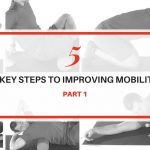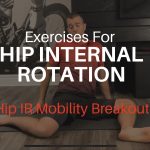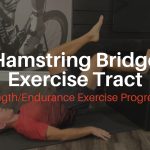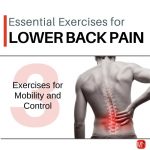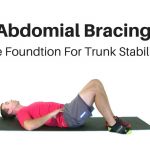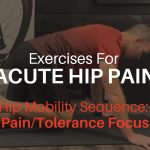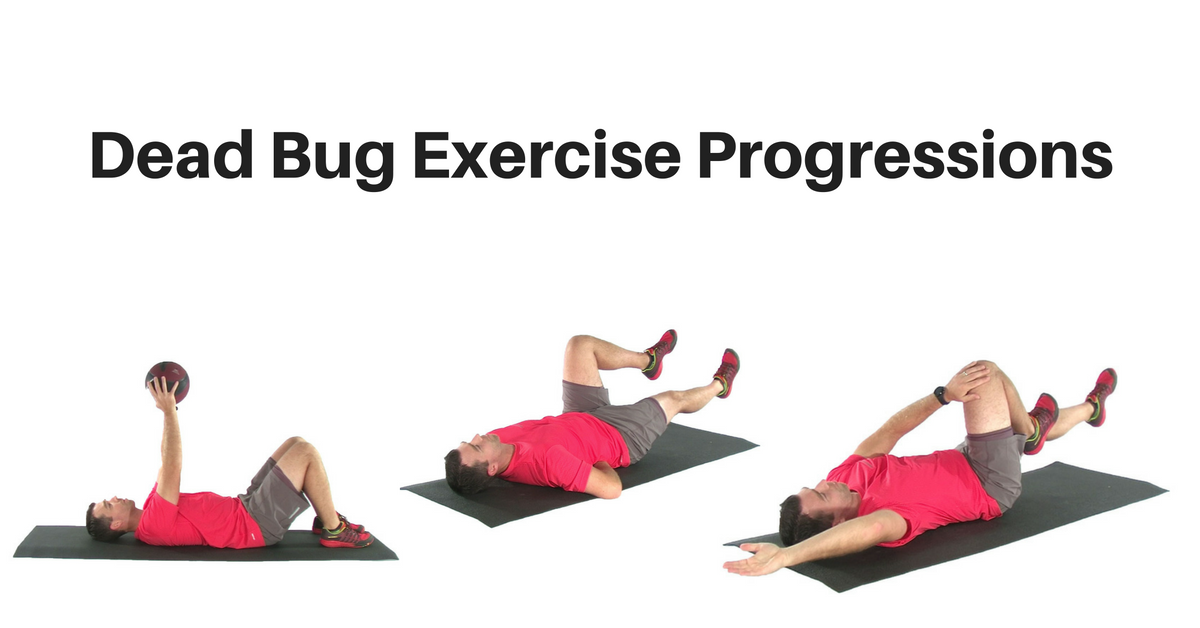
The Dead Bug is one of my absolute favorite go-to exercises to improve low back stability. Not only is it effective, but it is also completely scaleable.
In other words, it can be made extremely simple for those patients who are severely deconditioned. But can also be easily progressed to more challenging levels for more capable patients.
So instead of patients having to learn a completely new exercise as they gain more strength and control, we can simply add a slight (but very effective) tweak to what they are already doing. This is easier for the patient and saves a ton of time in your office.
In this article I will break down the dead bug exercise, and take you through the range of progressions you can use with your patients.
The Dead Bug Exercise
As discussed in many previous articles, stability is a joint’s capacity to maintain proper alignment under load and/or during movement. It is a joint’s ability to resist internal and external forces.
With the dead bug exercise, our goal is to first stabilize the spine by performing an abdominal brace (I discussed how to do this is detail in the previous article). We can then challenge this abdominal brace by adding arm and leg movements. The forces associated with this arm and leg motion will act to pull the lumbar spine out of alignment.
So the key with the dead bug exercise is to maintain a stable spine during limb movement. The forces acting to pull the lumbar spine out of alignment must be matched by the stabilizing force of the abdominal brace.
In the initial stages when the trunk muscles are weak and the patient has poor control, the limb movements need to be kept simple. As abdominal strength and control increase more forceful and complex limb movements can be used.
Lets take a look at the Dead-Bug progression. If you are a My Rehab Connection subscriber you can find this tract in the Exercise Groups section under the heading “Progression: Dead Bug”.
Dead Bug Exercise Progressions
Dead Bug with Foot Slide
This is the most basic version of the dead bug exercises. The key here is to 1) maintain the abdominal brace throughout the entire exercise, and 2) slide the foot along the floor. DO NOT lift the leg. This will engage the hip flexors and create additional extension / rotation load at the lumbo-pelvic region. Remember this exercise is for your most deconditioned patient, so even that little but of extra load will be too much. And don’t forget to breathe.
- Begin lying on your back with your knees bent and feet flat on the floor.
- Now perform an abdominal brace.
- Next straighten your leg by SLIDING your foot forward along the floor. You MUST maintain the abdominal brace
- Hold the leg extended for 1-2 seconds then slide your foot back towards your body.
- Perform 2 sets of 10-15 repetitions for each leg 1x/day.
Dead Bug with Overhead Reach
The dead bug with overhead reach begins to integrate movement of the upper extremity in an overhead movement pattern. The tendency is for the lower back to arch as the arms move closer towards the floor. You must maintain the abdominal brace to prevent this from happening. The heavier the weight the greater the challenge to trunk stability. Again, don’t forget to breathe.
- Begin lying on your back with your elbows extended and holding a weight straight overhead. Your knees should be bent with feet flat on the floor.
- Perform an abdominal brace.
- Now slowly lower the weight above your head towards the floor. Keep your abdominal muscles tight and do not allow your lower back to arch off the floor as you move.
- While keeping your abdominal muscles engaged pull the weight back towards the ceiling.
- Repeat this back and forth motion 10-15 times then relax your muscles. Perform 2 sets 1x/day.
Dead Bug with Leg Extension (Basic)
The Basic Dead Bug with Leg Extension is similar to the Dead Bug with Foot Slide, but instead of sliding the foot it is raised off the floor. This will engage the hip flexors and create and additional extension-rotation torque on the pelvis. The abdominal muscles must work harder to counteract this additional torque.
As the thigh is pulled back towards the truck there is often a tendency for the lower back to press into the floor. This also needs to be prevented as it is an indication the body is moving through the lumbar spine over the hip. It is often helpful to place your palms flat on the floor beneath your lower back to monitor this. When done correctly the pressure between your hands and lower back should remain constant for the entire exercise.
- Begin lying on your back with your knees bent and feet flat on the floor.
- Now lift your foot and extend your leg. Keep your abdominal muscles tight and do not allow your lower back to twist or arch.
- Now pull your leg back towards your trunk.
- Repeat this back and forth motion up 10 times then return your foot to the floor and relax your muscles.
- Perform 2 sets per leg 1x/day.
Dead Bug with Arm + Leg Extension (Basic)
The basic Dead Bug with Arm + Leg Extension begins to integrate opposing arm and leg motions. This creates a greater exercise challenge through increased load (there are more internal and external forces acting to pull the trunk out of alignment) as well as from a control/coordination perspective (you brain is now coordinating multiple movements).
- Begin lying on your back with your knees bent and feet flat on the floor. Place one palm flat on the floor beneath the small of your back (this hand will help monitor the position of your lower back).
- Perform an abdominal brace and bring your free hand and opposite knee together. Your lower back MUST remain stable as you do this.
- Now slowly extend your leg while reaching your arm overhead.
- Now bring your hand and knee together again.
- Slowly repeat this back and forth motion up to 10 times then return your foot to the floor and relax your muscles.
- Perform 2 sets per side 1x/day.
Dead Bug with Alternating Leg Extension (Bicycle Kick)
- Begin lying on your back with your knees bent and feet flat on the floor. Place your palms flat on the floor under the small of your back with your elbows resting on the floor.
- Perform an abdominal brace.
- Lift both legs off the ground (your hips and knees should be flexed to 90 degrees).
- Now slowly extend one leg then bring it back to your body.
- Now extend your opposite leg.
- Repeat this alternating motion 10 times / leg then return your foot to the floor and relax your muscles.
- Perform 2 sets 1x/day.
Dead Bug with Arm + Leg Extension (Advanced)
- Begin lying on your back with your knees bent and feet flat on the floor. Place one palm flat on the floor underneath the small of your back with your elbow resting on the floor.
- Perform an abdominal brace.
- Lift one leg off the ground (your hip and knee should be flexed to 90 degrees).
- Tighten your abdominal muscles and bring your free hand and opposite knee together.
- Now slowly extend your leg while lifting your arm overhead.
- Now bring your hand and knee together again.
- Slowly repeat this back and forth motion 10 times then return your foot to the floor and relax your muscles.
- Perform 2 sets per side 1x/day.
Dead Bug with Alternating Arm & Leg Extension (Full Dead Bug)
This is the most advanced version of the dead bug. To do this properly it requires a high level of strength, endurance, and control.
- Begin lying on your back with your knees bent and feet flat on the floor.
- Perform and abdominal brace.
- To start bring your hand and opposite knee together.
- Now keeping your hand and knee together extend your opposite arm and leg.
- Now bring your hand and knee together and extend your opposite side arm and leg.
- Slowly repeat this alternating arm and leg motion 10-20 times then return your limbs to the floor and relax your muscles.
- Perform 2 sets 1x/day.



